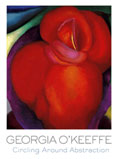
If O'Keeffe's approach to abstraction set her apart from her peers in the 1910s and early 1920s, it did so to an even greater extent by the 1930s. During this decade, the American artists who considered themselves to be the most "advanced" (many of whom banded together in 1936 to form the "American Abstract Artists" group) frequently incorporated into their work the hard-edged geometry of European painters such as Wassily Kandinsky, Fernand Léger, and Piet Mondrian. Some of O'Keeffe's other contemporaries, now known as the Precisionists, used simplification and refinement to create their streamlined images depicting modern machines and industry. These strategies were also essential to O'Keeffe, but she used them primarily to celebrate the natural world rather than the urban environment.
O'Keeffe's paintings also had little in common with those by America's most popular artists: the Regionalists. Led by the irascible Thomas Hart Benton, the Regionalists insisted that their homegrown narratives and stylized realism made their paintings the most important (and most "American") works of art being produced in this country. America, Benton wrote, demanded "socially and environmentally conditioned expression"-not heady, inaccessible abstraction, which he felt to be "foreign" and nothing but "empty purity."

